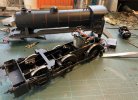dibateg
Western Thunderer
I bought 61738 second had a while back and after some tidying up has been a reliable performer on the Nottingham - Basford local service. As always after a running session, there are few locos to attend to and I'd noticed a clicking sound when the loco was running in reverse.
On examination, there was a catalogue of issues! Tender drawbar nut detached, a loose middle driving wheel, a delaminated coupling rod, one return crank loose and a loose cylinder wrapper... The original build was tidy, but the builder was very sparing with the solder.
Soldering a nut to a suface with no hole behind it is always going to fail, as when the screw is tightened it with just pull the nut off. So I made a bracket to retain it. The coupling rod only appeared to be soldered at the ends!
Anyway, all back together and ready for the next session.


On examination, there was a catalogue of issues! Tender drawbar nut detached, a loose middle driving wheel, a delaminated coupling rod, one return crank loose and a loose cylinder wrapper... The original build was tidy, but the builder was very sparing with the solder.
Soldering a nut to a suface with no hole behind it is always going to fail, as when the screw is tightened it with just pull the nut off. So I made a bracket to retain it. The coupling rod only appeared to be soldered at the ends!
Anyway, all back together and ready for the next session.




















